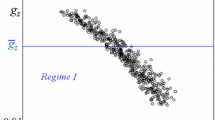Abstract
The purpose of the paper is to study fluctuations in a fragile economy, where the role of debt and income distribution is considered. It is based upon a macro approach that emphasizes interactions between market processes and macro constraints within an uncertain environment. By utilizing a regime switching approach, where behavioural functions change when a threshold is violated, robust dynamics can be generated. The model can mimic some aspects of the present evolution of the world economy by means of simulations.
Similar content being viewed by others
References
Aghion P, Banerjee A (2005) Volatility and growth. Oxford University Press, Oxford
Akerlof GA (2007) The missing motivation in macroeconomics. Am Econ Rev 97: 5–36
Brock W, Hommes C (1997) A rational route to randomness. Econometrica 65: 1059–1095
De Grauwe P (2008) Animal spirits and monetary policy, CESifo Working paper N0 2418
Delli Gatti D, Desiderio S, Gaffeo E, Cirillo P, Gallegati M (2010) Macroeconomics from the bottom-up., mimeo., Ancona, Italy
Di Guilmi C, Gallegati M, Landini S (2007) Financial fragility and the mean-field interaction as determinants of macroeconomic dynamics: a stochastic model. Working Paper, University of Ancona, Italy
Fazzari S, Ferri P, Greenberg E (2010) Investment and the Taylor rule in a dynamic Keynesian model. J Econ Dyn Control 34: 2010–2022
Ferri P (2011) Growth cycles and the financial instability hypothesis. Edward Elgar, Cheltenham
Ferri P, Minsky HP (1984) Prices, employment, and profits. J Post-Keynesian Econ VI: 489–499
Ferri P, Variato AM (2010) Uncertainty and learning in stochastic macro models. Int Adv Econ Res 16: 297–310
Fisher I (1933) Debt deflation theory of great depressions. Econometrica 1: 337–357
Flaschel P, Franke R, Semmler W (1997) Dynamic macroeconomics. The MIT Press, Cambridge, MA
Goodwin RM (1983) Essays in economic dynamics. Macmillan, London
Minsky HP (1982) Can “it” happen again?. Sharpe, New York
Minsky HP (1986) Stabilizing the unstable economy. Yale University Press, New Haven
Modigliani F, Miller M (1958) The cost of capital, corporative finance and the theory of investment. Am Econ Rev 48: 261–297
Reinhart CM, Reinhart VR (2010) After the fall. NBER, Working Paper 16334, Cambridge, MA
Reinhart CM, Rogoff KS (2010) From financial crash to debt crisis. NBER, Working Paper 15795, Cambridge, MA
Sargent T, Wallace N (1981) Some unpleasant monetarist arithmetic. Fed Reserv Bank Minneap Q Rev 5: 1–17
Tramontana F, Gardini L, Ferri P (2010) The dynamics of the Nairu model with two switching regimes. J Econ Dyn Control 34: 681–695
Author information
Authors and Affiliations
Corresponding author
Rights and permissions
About this article
Cite this article
Ferri, P. Income distribution and debts in a fragile economy: market processes and macro constraints. J Econ Interact Coord 8, 219–230 (2013). https://doi.org/10.1007/s11403-012-0091-8
Received:
Accepted:
Published:
Issue Date:
DOI: https://doi.org/10.1007/s11403-012-0091-8




